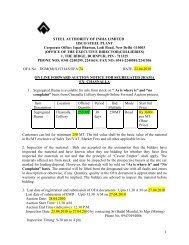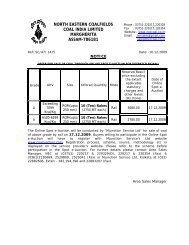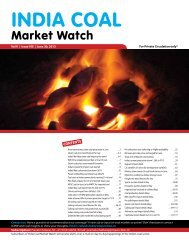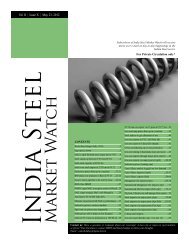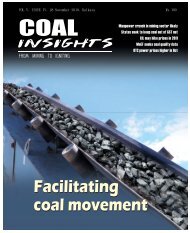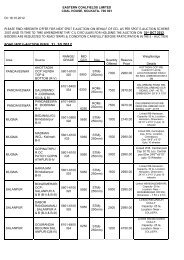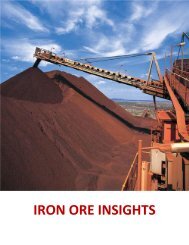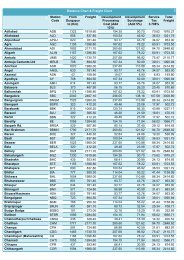India's largest coal handling agency - Mjunction
India's largest coal handling agency - Mjunction
India's largest coal handling agency - Mjunction
You also want an ePaper? Increase the reach of your titles
YUMPU automatically turns print PDFs into web optimized ePapers that Google loves.
Feature<br />
steel was estimated at around 66 mt in 2009-10. Coke is the<br />
crucial raw material for production of steel through the blast<br />
furnace route. At present the country is producing around<br />
22-26 mt of coke and importing another around 2.5 mt from<br />
countries like Colombia, Russia, and China.<br />
It is envisaged that India’s steel production will go up to<br />
around 110 million tons per annum (mtpa) by 2011-12 and<br />
further to around 200 mtpa by 2020. To achieve this production<br />
of steel, the country will need huge amount of coking <strong>coal</strong> to<br />
make coke that can be charged in blast furnaces.<br />
Going by this assumption, as per a conservative estimate<br />
the country will need around 100 mt of coking <strong>coal</strong> and around<br />
70 mt of LAM coke by 2011-12 and around 150 mt of coking<br />
<strong>coal</strong> and around 120 mt of coke by 2020.<br />
From the facts available, it is clear that the country will<br />
depend immensely on imported coking <strong>coal</strong> as well as LAM<br />
coke to produce the planned quantity of steel.<br />
The current global situation indicates that the country’s<br />
planned steel production capacities might face severe<br />
challenges largely due to non-availability of coking <strong>coal</strong><br />
as well as coke. Rumours are also rife in certain quarters<br />
that India may not achieve the planned steel production<br />
capacities due to limited availability of coking <strong>coal</strong> in the<br />
world market.<br />
Global situation<br />
Global metallurgical coke production currently hovers around<br />
500 million tons (mt) per year, 90 percent of which is used in<br />
the steel industry. A significant proportion of this global trade<br />
All about met coke<br />
Coal Insights Bureau<br />
Metallurgical coke, also known as “Met” coke,<br />
is a carbon material manufactured by the<br />
“destructive distillation” of various blends<br />
of bituminous <strong>coal</strong> (coking <strong>coal</strong> or metallurgical <strong>coal</strong>).<br />
Bituminous <strong>coal</strong> is a soft, medium grade <strong>coal</strong> that contains<br />
a high percentage of volatile components.<br />
Destructive distillation is performed in “coke<br />
batteries” which are banks of large enclosed kilns. Once<br />
the kilns are loaded, they are heated to approximately<br />
1000 degree Celcius in the absence of air.<br />
During the heat cycle the volatile components of<br />
the <strong>coal</strong> are released and the solid <strong>coal</strong> goes through a<br />
partial melt and subsequent re-solidification to a nonmelting<br />
carbon. Volatile components include <strong>coal</strong> tar,<br />
ammonia, and literally dozens of other “products of<br />
decomposition”. Most volatile components are reclaimed<br />
or recycled. The final solid is a non-melting carbon called<br />
metallurgical coke. As a result of the loss of volatile gases<br />
and of partial melting, Met coke has an open, porous<br />
morphology and may appear glassy in some specimens.<br />
As a result of the heat treatment process Met coke<br />
has a very low volatile content. However, the “ash”<br />
constituents, that were part of the original bituminous<br />
<strong>coal</strong> feedstock, remain encapsulated in the resultant coke.<br />
Met coke feedstocks are available in a wide range of sizes<br />
from fine powder to basketball-sized lumps. Typical<br />
purities range from 88 to 92 percent fixed carbon.<br />
Commercial grades are available in sizes from<br />
30-micrometer powders up to 20 cm lumps. Metallurgical<br />
coke is used where a high quality, tough, resilient,<br />
wearing carbon is required. Applications include but<br />
are not limited to conductive flooring, friction materials,<br />
foundry coatings, foundry carbon raiser, corrosion<br />
materials, drilling applications, reducing agents, heattreatment,<br />
ceramic packing media, electrolytic processes,<br />
and oxygen exclusion.<br />
Coke is made by destructive distillation of a blend<br />
of selected bituminous <strong>coal</strong>s (called Coking <strong>coal</strong> or<br />
Metallurgical <strong>coal</strong>) in special high temperature ovens in<br />
the absence of oxygen until a greater part of the volatile<br />
matter is driven off. The resulting product, Coke, consists<br />
principally of Carbon.<br />
Traditionally, chemistry, size & strength (both cold<br />
as well as hot) have been considered the most important<br />
properties for use in the blast furnace. The quality of the<br />
constituent <strong>coal</strong>s determines the characteristics of the<br />
resultant coke.<br />
Coke is primarily used to smelt iron ore and other<br />
bearing materials in blast furnaces, acting both as a source<br />
of heat and as a chemical reducing agent to produce pig<br />
iron or hot metal. Coke, iron ore and limestone are fed into<br />
blast furnace, which runs continuously. Hot air blown<br />
into the furnace burns the coke, which serves as source of<br />
heat and as an oxygen reducing agent to produce metallic<br />
iron. Limestone acts as a flux and also combines with<br />
impurities to form slag. Coke also serves as a structural<br />
material to support the deep bed of coke/iron oxide/<br />
limestone that makes up much of the furnace volume.<br />
It is in this last role that its properties are crucial. It<br />
is important that it does not degrade (e.g. break up into<br />
small particles) during its descent through the oxidizing<br />
hot gases passing through the stock region of the furnace.<br />
To produce high quality blast furnace coke, high<br />
quality <strong>coal</strong> must be used. High quality <strong>coal</strong>s are those<br />
<strong>coal</strong>s that when coked together produce the highest<br />
stability and CSR (Coke Strength after Reactivity) to<br />
support the blast furnace burden and allow maximum<br />
production.<br />
COAL INSIGHTS 32 October 2010



